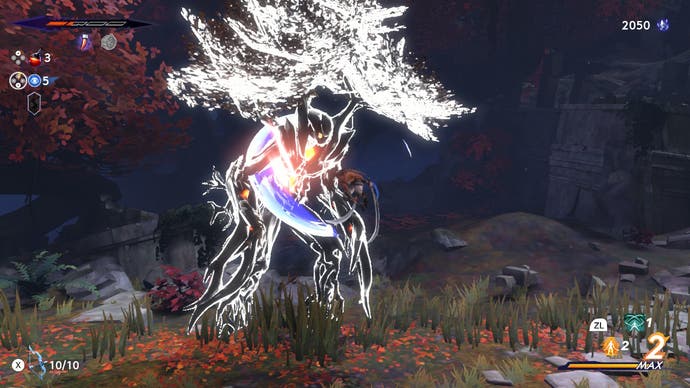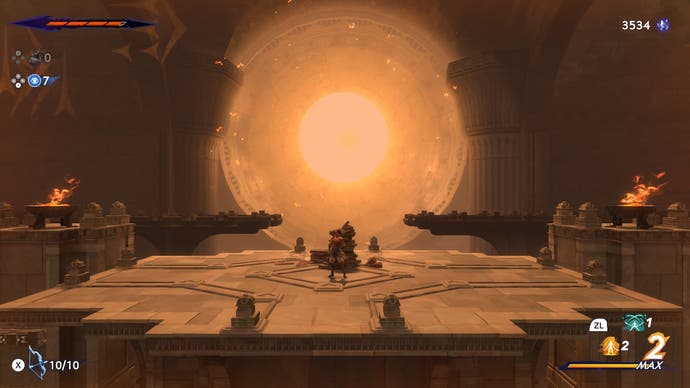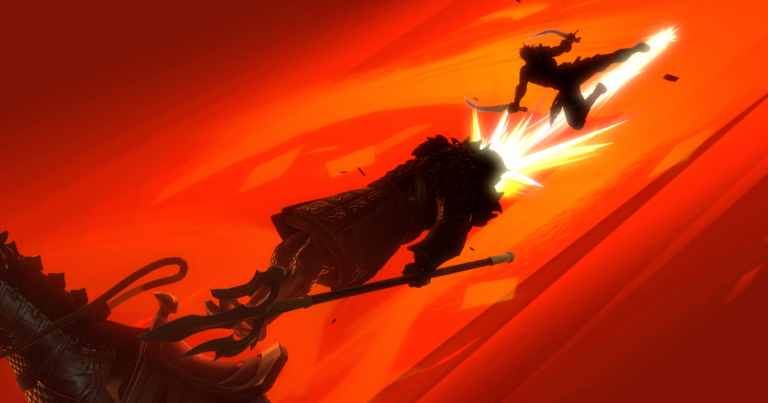[ad_1]
There's something about magical doors. Who can resist them? I can not do it. I don't know anyone who can.
There's a lot to see in Prince of Persia: The Lost Crown. This is the latest game in a popular series that dates back to the glory days of home computing. This is a very beautifully put together Metroidvania that feels like an example of the Planton format. This is a promising sign that Ubisoft is starting to let the soul of the series dictate the final structure of the game, rather than pouring its molten life into the same open-world mold. And it's a game that really knows the value and impact of magic doors.
So I'm in some kind of hub area, set up like a breezy Persian market. There will be someone nearby who you can talk to about different types of upgrades and trinkets, a little training on the nuances of combat, and even a little background on the story. But there is also this wall, and as you walk past it, you will see extracted shapes in warm gold colors. It looks like a door, but it's a door that takes me deep into the world, into three dimensions, and this game is mainly his 2D side-scrolling. Is it a door? Is it just a lighting quirk? what's happening?
“Lost Crown” is filled with such moments. As I said earlier, it's a venerable series and a venerable genre, but be prepared for some wonderful inventions, crafts, and truly heart-pounding moments.
I had long forgotten about the Prince of Persia game thread, but this latest installment feels like a bit of a rethink. You play as Sargon, a member of the immortal crew on a journey to rescue a prince who has been spirited away on a cursed mountain. As often happens when the Cursed Mountain enters the frame, things quickly go wrong. We're in Metroidvania territory as time and space begin to malfunction, monsters roam, flapping and thumping through the air with their pesky wings.
Manage cookie settings
Suddenly we find ourselves exploring a world of platforms stretching out in all directions, with doors and passages that require us to master certain skills before they can be opened. It's a game of thread combat and traversal through complex spaces, where players grapple with architectural chaos and keep in mind promising threads that aren't picked up now but could turn out to be interesting in a few hours. Ask for necessity.
On that last point, The Lost Crown has a great idea. At any time during the game, you can take a snapshot of your surroundings and paste it onto your map, giving you a visual reminder of where you want to return to later. Weird bulge that you can't reach? Strange glowing blocks that seem to make no sense? Snap! I'll come back when I know more. This is an attempt to reduce the memory burden of these most memory intensive games. It's also nice to do it with maps, a kind of Polaroid approach to the world of ancient mythology. i really like it.
The game also does a pretty good job in terms of combat, movement, and complex spaces. Let's look at these in turn.



Combat here is fast and stylish, with Sargon's dual blades and swipe combos quickly joined by a bow with decent auto-targeting. Hacking can be a lot of fun, especially given the approach to animation that lovingly lingers on the hero's poses, but the real crux of the fun lies in mastering the parry and dash system and figuring out what his flash of gold means. It is about learning. Counters attacks and deals additional damage. When you see a red flash, it means you can only move out of the way. With multiple enemies, or some bosses, spatial control is very important. As such, air dash (once you have it) and ground slide are great for closing gaps, opening gaps, or even slipping under enemies to attack them. What lies behind – the game is too happy that it could not have been anticipated at a particularly painful moment.
In addition to this, landing attacks builds up a special meter that, when filled, allows you to unleash a killer move. These are stackable, so reaching a certain level of the meter will allow you to play some specials, giving you more moves to trade out as things progress. For pure prosperity, I've become very fond of elaborate overhead attacks that do a lot of damage to what's above me, but my standard I've relied on pretty criminally in some encounters was the ability to place healing areas on the map. I then tried to stay inside while activating various bad guys around me. nice stuff.
Combat gives the game a nice crunchy sense of progression, and combines very cleanly with traversing the various rolling mountain-bow landscapes, an element of the game that feels equally intense and gymnastic. In other words, Sargon can walk, but that's of little importance here. Among other things, this is probably the best wall-jumping game ever made, with lots of spaces ending in wells and chimneys, allowing you to jump to whatever's next. Throw an aerial dash – autocorrect tried to give me an aerial dachshund, which is a promising game pitch in itself – and with a level that encourages you to look up and down as much as left and right, you always get a little It feels like a puzzle.
Admirably, Lost Crown works hard to chain moves together to get players through an incredibly satisfying gauntlet of platforming. The swinging blades and spike pits are beautifully reminiscent of the original Prince of Persia, while the crystal caverns mean death if you touch the surface, the sand pipes you can climb up and down, and the pirate caves where you have to avoid triggering traps. , or appear anywhere. You might figure out how to attack them against nearby enemies, and all kinds of sewers and caves. The game is beautiful, with rich colors, sharp edges, and a real skill for providing exciting scenery to watch in the background, but also with lasting pleasure. I think someone liked making this map. Created an evil passage, one moment covering it with a magical forest, the next moment with a castle crypt. I loved being here.


The unlockable skills that add traversal and provide classic Metroidvania gear gating tend to be a pretty standard idea for the genre, but they're delivered with flair. To name a few without spoiling everything, double jumps are always welcome, especially when the game is as long as this one. I also liked the novelty of grabbing an item from the world, holding it in a sort of Tetris holding slot, and then throwing it back into the world. Walls that need to be destroyed? Grab the exploding flowers, aim and hold at the right moment. Too many enemies? Tetris Keep some and when you bring them back into the world, they'll fight alongside you for a little while. All of this allows us to reach new parts of the map and think about old parts of humanity in different ways. And it's always fun to just mess around.
In other words, this is a really nice Metroidvania, and with some interesting uses of the series' existing time mechanics, you get something that really feels like a Prince of Persia game. Don't expect the ability to rewind the sands of time to define your adventure. But the cursed mountain you're exploring is a place where time has completely lost its own thread. You will always come across people who remember the events you experienced. Some claim that it has not been seen yet, or that it has been lost in this space for an incredibly long time. Some of the most interesting things here are also left in side quests. Metroidvania side quest! hold me.
In the words of my good friend Air Dushund, “What a rush.” Prince of Persia: The Lost Crown is a really fun game that embraces both the genre and its traditions, with great combat and exploration. This is a game that provides. And a strange secret door. Sold.
A copy of Prince of Persia: The Lost Crown was provided to me by Ubisoft for review.
[ad_2]
Source link


